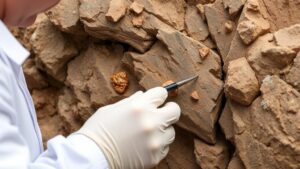Spotting Gravel Accumulations in Steep Canyons for Placer Gold Recovery
Spotting Gravel Accumulations in Steep Canyons for Placer Gold Recovery
Placer gold recovery involves extracting gold from alluvial deposits, typically found in riverbeds and floodplains. But, steep canyons present unique geological features that can effectively trap gravel accumulations containing placer gold. Understanding where and how to spot these gravel deposits can significantly enhance recovery efforts.
The Geology of Steep Canyons
Steep canyons are often defined by their narrow, steep-sided terrain formed through erosion by waterways. geological dynamics within these canyons promote the formation of distinct gravel accumulations. As water flows through these areas, it carries sediment and gold, dropping them when velocity decreases, particularly during changes in current or after heavy rains.
Key geological features to identify for spotting gravel accumulations include:
- Natural Drop-offs: Areas where the slope changes rapidly can lead to gold deposition.
- Confluences: Locations where two streams meet often experience decreased flow speed, facilitating sediment accumulation.
- Sandbars and Benches: Elevated sections along the canyon floor that slow water flow create natural traps for heavy minerals.
Indicators of Gold Presence
Gold often accompanies other minerals and specific indicators can suggest its presence in gravel deposits. Observing these signs is crucial in identifying lucrative sites for extraction:
- Black Sand: High concentrations of magnetite or hematite often correlate with gold deposits, as these dense materials can trap gold particles.
- Flakes and Nuggets: Visual identification of small gold flakes or nuggets among gravel is a direct indicator of placer deposits.
- Vegetation Changes: Areas with lush vegetation may indicate nutrient-rich soils where gold and sediment often accumulate.
Techniques for Locating Gravel Accumulations
Efficient placer mining revolves around targeted exploration. Several methods can be utilized to identify potential gravel accumulations in steep canyons:
- Surface Sampling: Collecting small samples from various locations within a canyon can provide insight into the presence of gold.
- Geophysical Surveys: Utilizing techniques such as ground-penetrating radar can help delineate subsurface gravel layers, indicating potential gold deposits.
- Hydraulic and Geomorphic Analysis: Detailed study of water flows and erosion patterns can illuminate previously unrecognized sites for placer deposits.
Real-World Applications and Case Studies
Numerous mining ventures have demonstrated success in utilizing the principles discussed above. For example, in the Sierra Nevada region of California, gold miners have consistently targeted gravel accumulations formed at the confluences of tributary streams and larger rivers. In these areas, success rates have increased by over 30% when miners specifically sought out natural drop-offs and benches.
Another noteworthy instance is the Klondike Gold Rush, where prospectors meticulously studied river geology to uncover rich deposits found in steep canyon regions. By recognizing indicators such as black sand and vegetation patterns, they were able to focus their efforts and greatly enhance their gold recovery rates.
Challenges and Considerations
While steep canyons can present rewarding opportunities, there are challenges to consider when prospecting for gold:
- Safety Risks: Steep terrain poses physical hazards including rockslides and unstable ground.
- Erosion and Accessibility: Continuous erosion can alter the landscape, making previously accessible areas difficult to mine.
- Water Rights and Regulations: Always review local mining regulations to ensure compliance with water use and mining rights, which can vary significantly by region.
Actionable Takeaways
For those looking to recover placer gold in steep canyons, several actionable strategies can enhance success:
- Conduct thorough geological surveys before initiating mining efforts.
- Focus on natural geological features that promote sediment accumulation.
- Use technology to assist with locating potential gravel deposits.
- Stay informed about local regulations and safety practices to minimize risks.
By following these guidelines, miners can increase their chances of successfully finding and extracting placer gold from steep canyon environments, turning the complexities of steep canyon geology into profitable opportunities.



